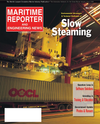
Page 33: of Maritime Reporter Magazine (May 2, 2010)
Read this page in Pdf, Flash or Html5 edition of May 2, 2010 Maritime Reporter Magazine
May 2010 www.marinelink.com 33 “Increased schedule flexibility will also allow ships to berth during different windows. Docking on weekdays or during daylight hours could, for ex- ample, cut overtime payments.”
Orient Overseas Container Line’s CL Ting, man- aging director of corporate planning, said slow steaming was a “win-win strategy” for carriers and shippers. “It makes economic and environmental sense. Burning less fuel saves money and it also re- duces greenhouse gas emissions,” Ting said.
The executives all believe the future of container shipping will involve sailing vessels at slower speeds. “Slow steaming is here to stay,” said Kolding.
Goh agreed, and said it was unlikely the world would ever return to the days of cheap fuel. “Given current economics, you have to wonder even if freight rates go up $500 per box, will lines be prepared to spend hundreds of millions of addi- tional dollars on fuel?”
Environmental concerns are also playing a greater role in regulatory measures, with the International
Maritime Organization and governments worldwide tightening requirements for cleaner fuels and more fuel-efficient vessels.
This would have a significant impact on shipping lines, Ting believed. “Further down the road, car- bon taxes and cap-and-trade climate policies are under consideration and may have lasting effects on liner shipping operations and costs for both carri- ers and shippers. “In the meantime, slow steaming can be imple- mented immediately,” he said.
But as with any technical issue there are some se- rious pros and cons. On the positive side, sailing slower also cuts down on harmful fuel emissions, and with a carbon trading system an inevitability, having engines that can operate at slower speeds and use less fuel will be critical.
The engine issue also falls on the “cons” side of the argument. Possibly the greatest issue facing slow steaming is the uncertainty of how sustainable it is operating engines slower than their designed speed.
Much research still needs to be done, but accord- ing to engine manufacturer Wärtsilä, possible con- sequences of running unmodified engines at low speeds include lower airflows, poor combustion and cold corrosion. This causes excessive component temperatures and an increased risk of engine foul- ing. There are harmful vibrations to consider that could cause failures of crankshafts and shaft con- nections.
Of course, no discussion on slow steaming would be complete without the views of the people who use container vessels to ship their cargo – the ship- pers. Electrolux vice-president of global freight
Bjorn Vang Jensen said while he accepted the rea- soning behind slow steaming, he was not prepared to pay more for a longer transit time. “Paying for a service is one thing, but I don’t see us paying more for a service that adds an extra 10 days or more to my transit time,” he said. “We would expect lower rates for such a service.”
Jean-Louis Cambon, head of tire maker Miche- lin’s ocean management committee – and recently appointed to the European Shippers’ Council’s in- fluential Maritime Transport Council – said super slow steaming on the Asia-Europe trade would see nine, and even up to 12 ships in the future, deployed per string. “In that scenario, the total round-trip time would move from the current 63 days to 84 days and, seen from a shipper’s perspective, this is a big change,” he wrote in the Shippers’ Voice, an independent net- working website for shippers. “It follows that stock levels will suffer quite a lot, and looking at it from a total cost perspective, this will cost a lot of money.”
Service was always a unique selling point in the container line business, and Alphaliner’s Tan said in the past, most carriers competed on the basis of faster transit times. Slowing down vessels was a complete reversal of what liners were offering to their shippers. “But still, a lot of shippers will forego transit time if it means a more reliable service.”
While the immediate financial benefits are attrac- tive, the technical side of the argument is not so clear cut, ensuring the debate over the merits of slow steaming will be with the container shipping sector for a long time.
However, with such calamitous financial losses last year, the industry’s most pressing order of busi- ness is to find a sustainable pricing model. Slow steaming may offer an opportunity to relieve oper- ating cost pressures, but it is higher freight rates that will ultimately lead carriers back into the black.

 32
32

 34
34
